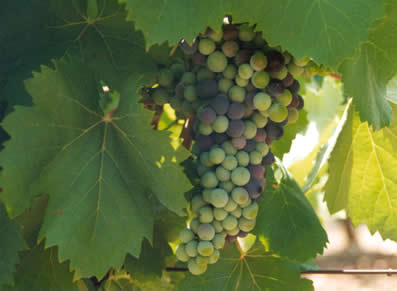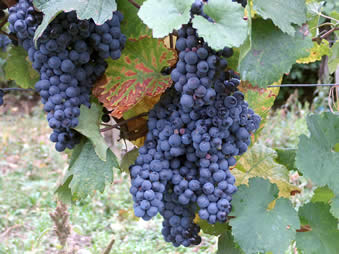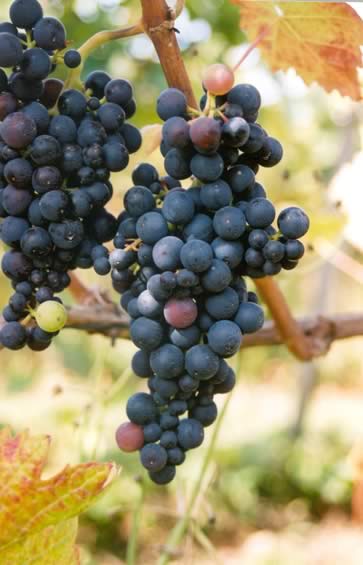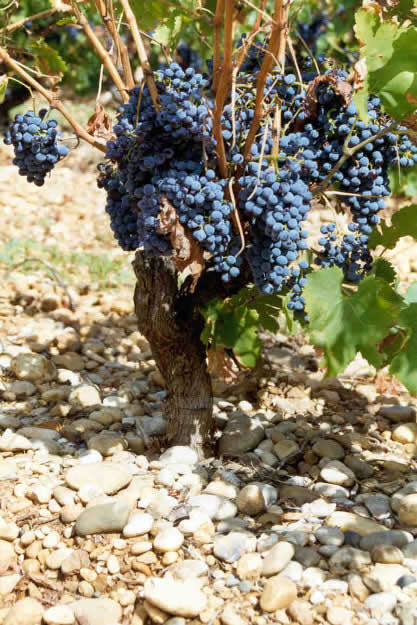|
Ripeness
 Grapes
are for the birds. In their natural habitat grapevines are climbing
plants, designed to grow rapidly up trees and reach sunlight through
gaps in the canopy. It’s a freeloading sort of existence, taking
advantage of the trees’ patient work of developing a solid trunk to
help them grow slowly but steadily to gain pole position in
competition for light. The grapevine makes no such attempt to grow a
self-supporting stucture, but instead grows quickly, with long flimsy
stems. Its tendrils are a vital adaptation to this lifestyle, as is a
root system that grows deeply to scavenge resources from under the
nose of its more established host. Then, in order to reproduce the
vine produces bunches of red berries to tempt birds, who eat the fruit
and disperse the seeds with their own ready made dollop of fertilizer. Grapes
are for the birds. In their natural habitat grapevines are climbing
plants, designed to grow rapidly up trees and reach sunlight through
gaps in the canopy. It’s a freeloading sort of existence, taking
advantage of the trees’ patient work of developing a solid trunk to
help them grow slowly but steadily to gain pole position in
competition for light. The grapevine makes no such attempt to grow a
self-supporting stucture, but instead grows quickly, with long flimsy
stems. Its tendrils are a vital adaptation to this lifestyle, as is a
root system that grows deeply to scavenge resources from under the
nose of its more established host. Then, in order to reproduce the
vine produces bunches of red berries to tempt birds, who eat the fruit
and disperse the seeds with their own ready made dollop of fertilizer.
Veraison, the colour change
from green to purple black, via red, is an important process. It’s
the vine’s way of getting birds to eat the grapes at the right time.
While the grapes are green, they are camoufluaged. They are also
rendered unpalatable by high levels of a range of compounds, including
acids, methoxypyrazine (the ‘green’ or grassy tasting chemical
that at lower levels helps contribute to the New Zealand style of
Sauvignon Blanc), and bitter-tasting tannins.
As the growing season
progresses and the seeds of the grapes ripen, a series of
physiological changes occur in the berries. Most  visible
is the colour change, a visual indicator of unseen chemical
transformations that will make the berries taste sweeter and more
rewarding. Incidentally, in their wild state all grapes were dark
coloured. White (or more strictly speaking, yellow) varieties arose as
a genetic mutation, which has recently been shown to be due to a
change in a gene that regulates the production of anthocyanins, the
red/blue–black pigments that gives dark grapes their colour. visible
is the colour change, a visual indicator of unseen chemical
transformations that will make the berries taste sweeter and more
rewarding. Incidentally, in their wild state all grapes were dark
coloured. White (or more strictly speaking, yellow) varieties arose as
a genetic mutation, which has recently been shown to be due to a
change in a gene that regulates the production of anthocyanins, the
red/blue–black pigments that gives dark grapes their colour.
As this ripening process
proceeds, sugars accumulate in the berries and the acidity levels
drop. There are changes in the tannins, which become less
bitter-tasting and softer, and the methoxypyrazine levels decrease,
making the grapes taste less green or herbaceous. These changes are
all highly significant from a winemaking perspective.
The timing of ripening is
significant. It coincides with the onset of autumn. In the vine’s
natural range, summers are typically hot and dry: not ideal conditions
for seeds to germinate and young plants flourish. I suspect that by
delaying ripening until autumn, the vine gains two advantages. First,
the grapes are appearing at a time where the abundant food supplies of
summer are waning, and so they are even more attractive to the birds
who then have fewer alternative food  supplies.
Second, the autumn rains make conditions ideal for the establishment
of new plants (although I’m not absolutely certain that the vine
seeds germinate at this stage; they may well wait until the following
spring). This, however, creates headaches for wine growers who want to
harvest in dry conditions, and don’t want to see their crop being
devoured by birds. supplies.
Second, the autumn rains make conditions ideal for the establishment
of new plants (although I’m not absolutely certain that the vine
seeds germinate at this stage; they may well wait until the following
spring). This, however, creates headaches for wine growers who want to
harvest in dry conditions, and don’t want to see their crop being
devoured by birds.
Winemakers commonly make a
distinction between two rather separate ripening processes, known as
phenolic ripeness and sugar ripeness, although this distinction is
contested by some. Phenolic ripeness (also referred to as
physiological ripeness) refers to the changes in the tannins that
occur in grape skins, seeds and stems. Sugar ripeness refers to the
breakdown of acids and accumulation of sugars. In the classic northern
hemisphere regions, grapes are typically harvested by sugar ripeness.
In many vintages it’s a question of getting the grapes as ripe as
possible before autumn rains set in, and usually the phenolic ripeness
is satisfactory where yields have been kept sane.
In warmer regions the
growers get better results picking by phenolic ripeness, because this
often trails sugar ripeness. Warm regions have no problem producing
grapes with high levels of sugar and thus potential alcohol, and here
the challenge is to get grapes to reach phenolic ripeness without
making wines with heroic alcohol levels and no natural acidity. It’s
no good picking earlier at 13 degrees potential alcohol in order to
avoid an alcoholic wine, because if the phenolic ripeness isn’t
adequate the wine will have an unpleasant green, unripe flavour to it.
 Are
phenolic ripeness and sugar ripeness independent of each other?
Clearly not; at the very least, there’s a correlation. But it does
seem that phenolic ripeness is more related to hang time than sugar
ripeness is; by this, I mean sugar ripeness seems more tuned to the
sunlight and warmth of the particular vintage, whereas phenolic
ripeness is less closely tied to these vintage conditions. I suspect
this is quite a controversial statement. Are
phenolic ripeness and sugar ripeness independent of each other?
Clearly not; at the very least, there’s a correlation. But it does
seem that phenolic ripeness is more related to hang time than sugar
ripeness is; by this, I mean sugar ripeness seems more tuned to the
sunlight and warmth of the particular vintage, whereas phenolic
ripeness is less closely tied to these vintage conditions. I suspect
this is quite a controversial statement.
What are wine growers aiming
for? ‘Perfect’ ripeness is achieved when sugar levels are high
enough but not too high to make a wine that has moderate alcohol
levels; when acidity is naturally just right; when phenolics such as
tannins are at the right stage; and when fruit flavours are
appropriate from the wine style in question (for red wines, are they
red or black, for example?). There are also a range of other chemicals
found in grapes that will change in composition with the ripening
process. Because many of these changes occur with different
trajectories and are impacted by different factors, finding this place
of perfect ripening balance can be an elusive goal.
The ideal vineyard sites are
those which, in an average vintage, yield perfectly ripe grapes. Of
course, it’s likely that there is a window of ‘perfect ripeness’
for each variety, where within the spectrum of perfect ripeness there
lie stylistic differences. Outside this window we have on the one hand
under-ripeness, and on the other over-ripeness. Some commentators
point out that currently many new world producers are erring on the
side of over-ripeness by leaving the fruit on the vine too long – a
practice known as excessive ‘hang time’, and which results in what
some have described as ‘dead fruit wines’. Certainly, high alcohol
levels caused by excessive sugar ripeness are a real problem: the
alcohol levels for many wine styles have been creeping up over recent
years, and it’s likely that they are having a detrimental sensory
impact.
 One
of the interesting things about wine is how the same grape variety can
perform differently grown in different places. Fully ripe Chardonnay
grapes in Burgundy make wines that taste different to those made from
fully ripe Chardonnay grapes grown in California. It’s also possible
to discern the difference in style between wines made from ripe grapes
grown in one part of California from another, or one part of Burgundy
from another. And you don’t get Burgundy just by picking grapes from
Sonoma early; you just get unripe California Chardonnay. One
of the interesting things about wine is how the same grape variety can
perform differently grown in different places. Fully ripe Chardonnay
grapes in Burgundy make wines that taste different to those made from
fully ripe Chardonnay grapes grown in California. It’s also possible
to discern the difference in style between wines made from ripe grapes
grown in one part of California from another, or one part of Burgundy
from another. And you don’t get Burgundy just by picking grapes from
Sonoma early; you just get unripe California Chardonnay.
Finally, I’ll close this
rather meandering piece by looking at the interesting question of
homogeneity of ripeness within a vineyard, and whether this is
positive for wine quality. It’s clear that to blend together unripe
grapes and over-ripe grapes doesn’t result in a balanced wine.
Indeed, under-ripe grapes are completely undesirable and can ruin a
wine, not add freshness. Having said this, a tiny bit of greenness in
red wines can be a good thing – many top red Burgundies and Bordeaux
have just a hint of greenness to them in their youth, but age very
well. Generally, though, I get the impression that rigorous selection
in the winery to root out unripe grapes and ensure as homogeneous crop
ripeness as possible is probably an important contributor to wine
quality.
Back to top
|